Northern European Trek
Amsterdam, Netherlands
Tuesday, July 30, 2013
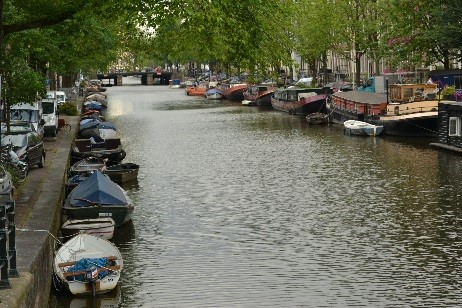
We really loved our 17 days of cruising the North Atlantic. We experienced so many destinations, met some great people, and simply loved sailing the awesome North Atlantic. However, the human condition always has us wishing we were someplace else, and so it was with Julia and me. We both couldn't wait to be off the mighty Veendam and in Amsterdam. Just two short sea-nights had our wish fulfilled; we arrived in the great city of Amsterdam on time and raring to start our Northern European Trek.
First stop in the city of sex, drugs, and bicycles was our hotel, the Dikker & Thijs Fenice, on the lovely Prinsengracht canal. Julia chose this hotel well as it is very central, not expensive, and very clean. After unexpectedly checking in on our arrival at 9:00 a.m., we dropped off our bags and began our touring.
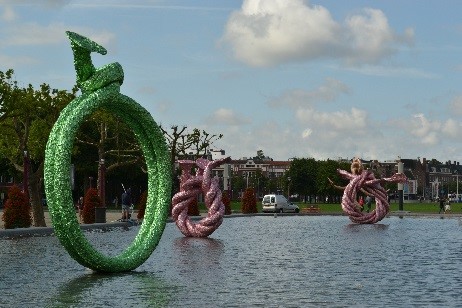 The first of the many museums that caught our eye was the Dutch Resistance Museum, located near the Amsterdam Zoo. Man, this was a terrific experience and gave an insightful look into life in Amsterdam before, during, and just after World War Two. When given the circumstances, humans can really behave badly toward each other. This museum helps you understand these harsh and hostile times.
The first of the many museums that caught our eye was the Dutch Resistance Museum, located near the Amsterdam Zoo. Man, this was a terrific experience and gave an insightful look into life in Amsterdam before, during, and just after World War Two. When given the circumstances, humans can really behave badly toward each other. This museum helps you understand these harsh and hostile times.
After eating a delicious lunch, we continued our unguided walk around this colorful city. The combination of canals, small streets, old and new architecture, and all of the bicycles makes this city one of the most unique cities in the world.
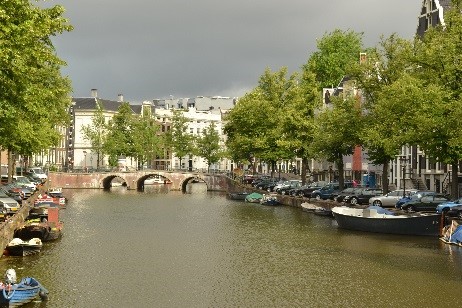 You know marijuana has been legal here for a long time. We did not notice that the city had fallen into rack and ruin; quite the contrary, the place is a marvel. So much for the arguments against the legalization of recreational drugs.
You know marijuana has been legal here for a long time. We did not notice that the city had fallen into rack and ruin; quite the contrary, the place is a marvel. So much for the arguments against the legalization of recreational drugs.
Wednesday, July 31, 2013
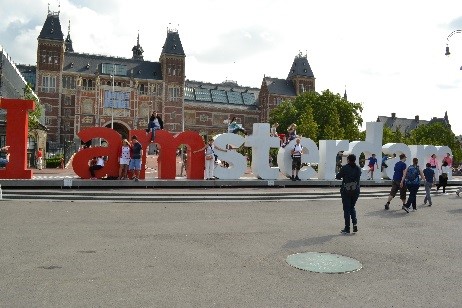
We visited the Van Gogh and Rembrandt's House museums today. It turns out to beat the crowds, you best get to the Van Gogh museum when they first open in the morning. But we didn't learn this until after we paid extra for a ticket that gave us access to the museum at a set time with a promise that there would be no waiting. We ended up in a long line with all the other saps that had forked out for this unredeemed promise. Both museums were worth a visit as the art they contain is very beautiful and alluring. The Rembrandt's House museum had the added benefit of offering insight into the talented painter's life and how he lived.
Amsterdam, Netherlands
Thursday, August 01, 2013
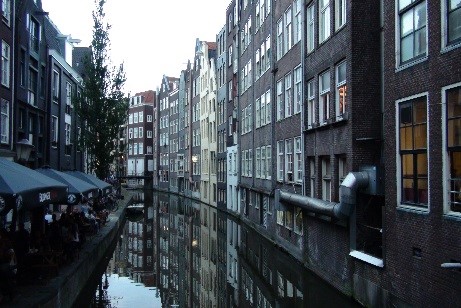
This morning we were up early and at the front doors of the Rijks museum when they first opened. Lo and behold, there were no lines, and for about an hour, Julia and I felt we had the whole place to ourselves; amazing what a difference early rising can make. The Rijks is overflowing with Rembrandt's art along with many other brilliant artists, and the building is a pleasure to experience. It has to be one of the best-laid-out museums I've visited, and its enormous rooms and atriums set an impressive tone.
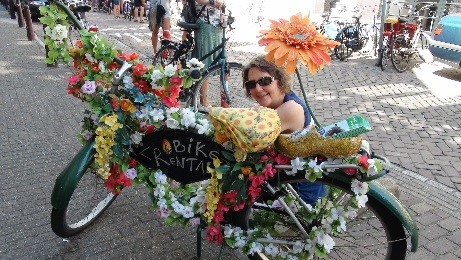
No visit to Amsterdam could be complete without joining the locals in their favorite pastime of riding bicycles around the vibrant city. And so, Julia and I embarked on a bike tour of this city of sex, drugs, and bicycles. This was a lot of fun, and the tour guide was an extremely informative and entertaining personality. You must keep in mind the rules of the road when in Amsterdam. They are: pedestrians, bicycles, motorcycles, and trams all share the same small spaces. Motorcycles give way to cars, which give way to trams, which give way to no one. Oh yes, and pedestrians give way to everything or get run over. Remember to be alert when walking the city that was named for the damming of the Amstel River.
Bremen, Germany
Friday, August 02, 2013
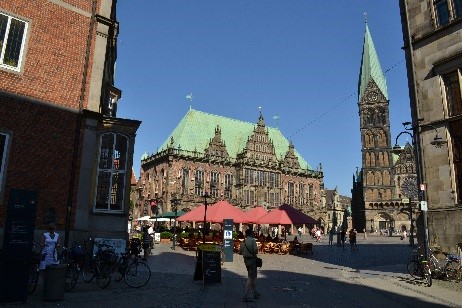
With some sadness, but also great anticipation of the journey that lay before us, Julia and I left Amsterdam behind today. We picked up a rental car and began the road-trip section of our Northern European Trek. It was unusually hot this day, 93° Fahrenheit, so sitting in an air-conditioned car with the deep green scenery of the Netherlands and Germany zipping past us was the place to be. After encountering a massive pile-up on the Autobahn, my memory was jogged about how fast everyone drives in Germany. The speed limit is posted at 130 KPH, but we had people fly past us at over 200 KPH. They must have many accidents on these Autobahn, but we continued unharmed to our destination: Bremen.
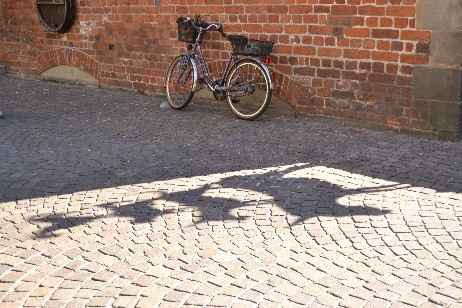
The 550,000 people of the little town of Bremen sure have a great place to live. It got bombed heavily during WWII, but it looks great today. In the Grimm's story Die Bremer Stadtmusikanten (Town Musicians of Bremen), the donkey, dog, cat, and rooster never actually made it to Bremen, but they would have fallen in love with the place if they had. This little city is big on charm, from the statues of the famous fairy-tale characters to the jaw-dropping art-nouveau laneway to its impressive buildings. On top of that, the waterfront promenade along the Weser River is a relaxing refuge where Julia and I enjoyed a light dinner of antipasti washed down with delicious local beer and wine.
Bremen, Germany
Ribe, Denmark
Saturday, August 3, 2013
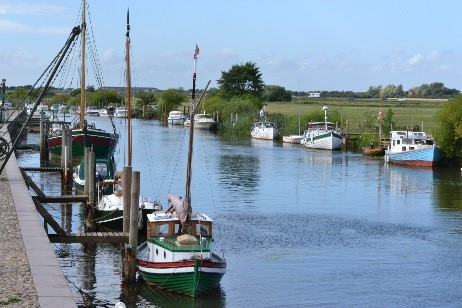
We were up early today for a long drive north to Ribe in Denmark. All was going well until the Autobahn became a parking lot just as it had yesterday. Another car accident caused by driving too fast, I imagine. We never found out as we decided to leave the Autobahn and trust in the GPS power of our TomTom to navigate us through secondary roads to our destination. We were pleasantly surprised as our electronic navigator took us down extremely tiny emerald-green country lanes, via particularly cute little villages, and at one point had us drive onto a ferry to cross an unknown river, for free, amazing. Our offbeat drive revealed to me that almost every roof in northern Germany is covered in photovoltaic cells, and the land is bristling with giant wind turbines. Germany has to be making the most concerted effort to capture and utilize renewable energies than any other place on Earth.
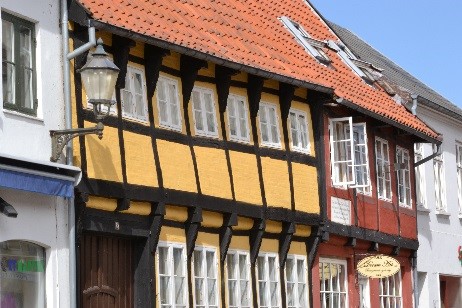
We arrived in the lovely old city of Ribe later than we'd originally planned, but that was okay as we weren't in a rush. We were astounded at just how quaint this medieval town is. We climbed the bell tower of its piecemeal gothic church and were able to survey the tiny windy streets of Ribe and the beautiful countryside surrounding it. We walked the river running through the town and discovered several ancient water gates controlling its flow. We visited the earthen remains of its 13th-century castle built by the then King to extend his influence into the prosperous region. Finally, we struggled to order our dinner from a helpful but Danish-only-speaking waitress. Thank goodness for the universal communication powers of gesticulation. We tried to use Google Translate, but it failed miserably to help us penetrate the convoluted depths of the Danish language.
Ribe, Denmark
Copenhagen, Denmark
Sunday, August 4, 2013
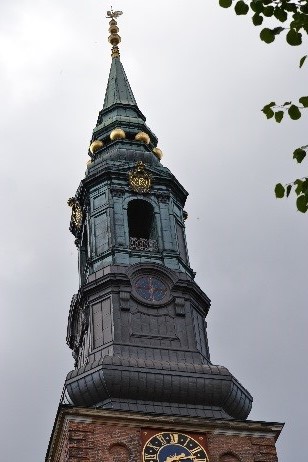
All I can say about Copenhagen so far is:
Wonderful, wonderful Copenhagen
Friendly old girl of a town
"Neath her tavern light
On this merry night
Let us clink and drink one down
To wonderful, wonderful Copenhagen
Salty old queen of the sea
Once I sailed away
But I'm home today
Singing Copenhagen, wonderful, wonderful
Copenhagen for me
Danny Kaye, go on, click it
Copenhagen, Denmark
Kobenhavn, Denmark
August 5 to 6, 2013
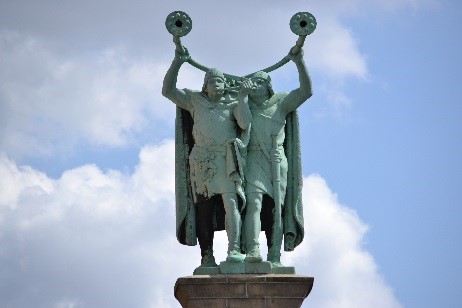
Denmark consists of the Jutland peninsula and the Danish archipelago of 407 islands. It is characterized by flat, arable land, lovely sandy coasts, and a temperate climate. Denmark is a small country in terms of population with around 5.6 million inhabitants. Kobenhavn, or Copenhagen as we outsiders know it, is the capital city of this ancient land. The city is a pleasure to visit, and its many parks, rivers, canals, castles, and waterfronts are all very accessible to the eager traveler. Julia and I visited one of the major attractions in the city of Danes, the Rosenborg Castle, to get a glimpse of the royal bling. This castle is small in relation to others in Europe, but it is packed full of royal goodies.
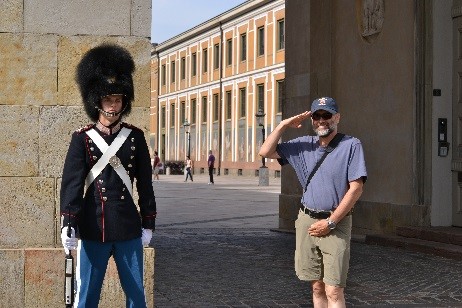
I didn't realize that the city was occupied with armed guards. Their purpose seems more ceremonial than as enforcers, similar to the guards you see in London. They even wear the same tall bearskin hats. It was fascinating watching them march back and forth like wind-up soldiers trying hard to ignore the many tourists crowding around them.
Another unexpected discovery about this surprising city is its food. Apparently, Copenhagen has the most Michelin-starred restaurants in Europe. I can personally verify that the food is good here, having had several delicious experiences of Danish fare.
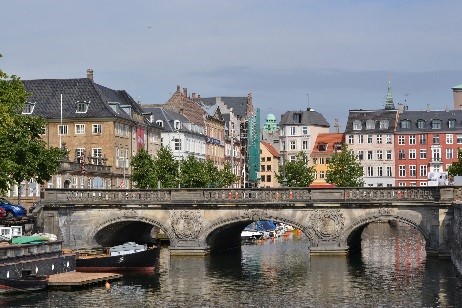
The Renaissance Danish dabbled in empire building, just like their expansionist Viking ancestors. But then so did everyone in this region of the world at one time or another. The Vikings traveled across the world from North America to Russia, and from North Africa to Constantinople. The Jutes, the people that came before the Vikings, migrated as far as England and left behind a gene trail that is still visible in the faces of the people today.
Helsingor, Denmark
Wednesday, August 7, 2013
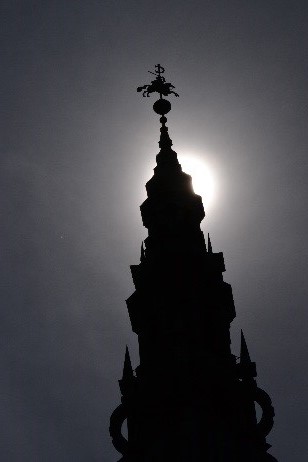
Bags packed and ready for adventure, we jumped into the car, turned the key, but nothing happened. Not a drop of juice in the battery. Luckily, a phone call and two cappuccinos later, a gorgeous Danish woman arrived in a big truck, with mechanical expertise, and got us on our way. The car has kept going since, although it intermittently beeps and displays "code 26" on the dash. The instruction manual is in Dutch, and it is double Dutch to us.
As fans of Mads Mikkelsen, the brilliant Danish actor from Copenhagen, we fantasized that we would catch a glimpse of him somewhere in town. Our dream almost came true, as our gorgeous Viking car mechanic had met him before he reached stardom. She said, "he is a really nice guy."
Despite continuing to grumble with "code 61" and "code 26," our car made it to the town of Helsingor and to the magnificent Kronborg Castle. It is Hamlet's castle, or at least the castle Shakespeare had in mind when he wrote the masterpiece. The castle is at the entrance to the Baltic Sea, and for hundreds of years, ships had to pay gold coin for their passage. The owners were fabulously wealthy as a result, and the castle was famous in Shakespeare's Europe.
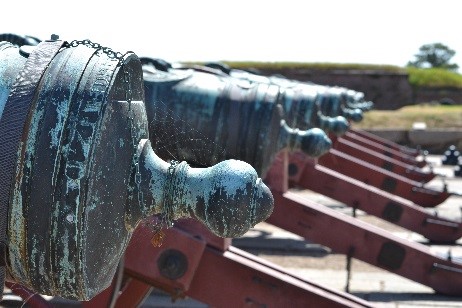
And Shakespeare may also have known traveling actors who performed at the castle, or maybe he went there himself, no one knows for sure. Hamlet is Shakespeare's version of an earlier story about Amleth, Prince of Denmark, whose father was murdered, and whose mother married his uncle, and who feigns madness to survive.
We crossed via ferry into Sweden and entered the unknown; literally, as our rented GPS had no map of Sweden. Thank Darwin for Google Maps and cell phones, which navigated us through the Swedish forests.
Helsingor, Denmark
Varnamo and Store Mosse National Park, Sweden
Wednesday, August 7, 2013
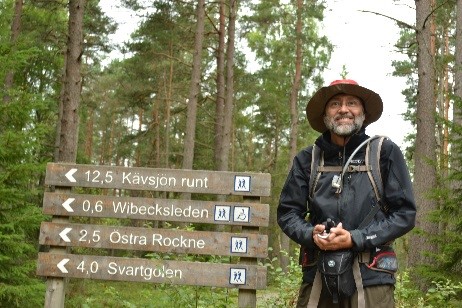
Today's weather matched the very wet forecast, but rain did not deter us from hiking in the extremely green and mossy Store Mosse National Park. The park's wilderness is a mixture of bogs, ancient sand dunes, and forests, all upon antediluvian 3-billion-year-old Swedish bedrock. After bundling ourselves into waterproofs, we set out into the vast marshland. In the boggiest places, there were wood planks to walk on. Some were (what we referred to as) wobblers, and some were flappers because of the way they moved underfoot, but we were very happy they were there most of the time.
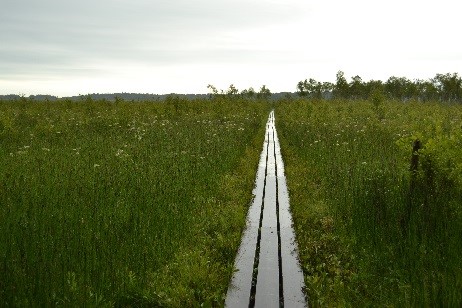
We walked through an Iron Age burial ground and sheltered to eat our obligatory cheese sandwiches in an old wooden hut. There are elk and eagles in the park, but we saw neither on our trek. Eight miles later, and back at the hotel, we hoped our sodden boots would dry on the windowsill as we listened to more rain pouring and ducks quacking outside; at least Julia said they were ducks.
Store Mosse, Sweden
Stockholm and Tyresta National Park, Sweden
August 8, 9, 10, 2013
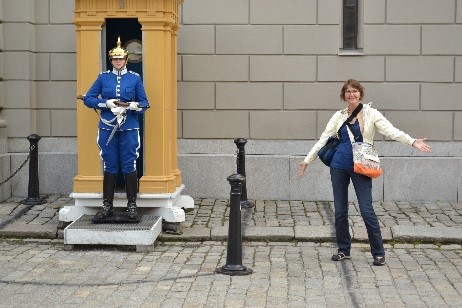
Thirty years ago, David and friends spent a freezing few days in Stockholm; the river was frozen, everything was white with snow, and it was very cold for the three intrepid Aussies. This time, it is summer in the northern city. Everyone is outside, enjoying light and warmth, and the whole city feels like a giant outdoor party. Even in the graveyard (sounds creepy, but looks weirdly lovely) outside our hotel window, there are hares bouncing around, feasting on the summer grass! Stockholm is buzzing with life.
We spent our first day in the city by leaving it. Nearby the vibrant metropolis is Tyresta National Park, a piece of pristine primeval Swedish forest we were compelled to explore.
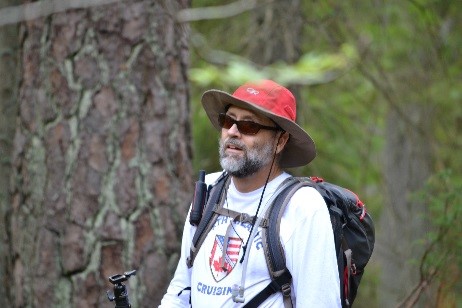
We hiked through trees growing out of moss-covered granite and ate our scrumptious cheese sandwiches on the shore of a lake that reflected the clouds and forest in its glassy calm water.
Traditional Swedish food is just what you need after 10 miles of hiking through a primeval forest, and we got it at a restaurant called Tradition. The restaurant's bread is made to a secret family recipe, and the sticky, almost black bread tastes of licorice and molasses. We ate cabbage pudding, black pudding, homemade mustard, and rhubarb crumble, and the bread, oh the bread.
Stockholm, Sweden
Sunday, August 11, 2013
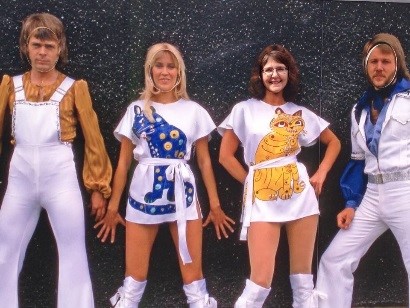
"Mamma mia, here I go again My my, how can I resist you?" We couldn't resist the ABBA museum and the chance for some 1970s fashion and music immersion. ABBA was great, and so was the exhibit. We got to sing along, dance, marvel at the musicians' talent, determination, hard work, luck, platform shoes, and fabulous costumes.
Next, on to something completely different and the Nobel Museum, where we saw lots about every spectrum of human possibility from the best to the worst. Alfred Nobel invented dynamite. Maybe guilt about the turbulent invention, which spurred on the Age of Anthropocene and caused massive amounts of death and destruction, made him leave so much of his fortune for the Nobel Prizes. Whatever the reason, it is wonderful that he did as so many brave and brilliant people are given recognition and financial reward.
Uppsala, Sweden
Monday, August 12, 2013
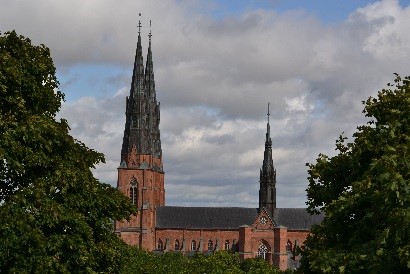
Summer is over in Sweden. The wind, rain, and thunderous groans of the great god Odin roar over the city as he mourns the loss of sunshine. Still, we decided to visit the quaint university town of Uppsala further north in this land of Norse gods. The university has existed since the 15th century, and we were amazed to see an original musical manuscript by Mozart in the library, as well as some incredibly old maps and 1,000-year-old religious fiction texts; they are valuable for their age if not for their content.
We forgot that museums are usually closed on Mondays, so we couldn't go inside Linnaeus's garden and house; we just peeked through its iron gate. Linnaeus was a great scientist and classifier of living things into genus and species, which was helpful to Darwin when he was developing his thoughts about natural selection; truth is always more rewarding than fiction.
Saint Petersburg, Russia
Tuesday, August 13, 2013
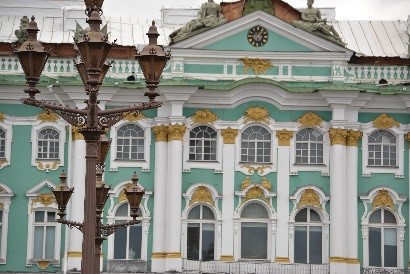
After a short flight from Stockholm, we are still in Europe, but we feel as though we are on the edge of familiar ground. As we walk the streets of our new destination, there are people smoking hookahs, crumbling decaying buildings, strange smells, and the faces in the crowds are different, as well as the churches and their icons. Europe has ended; something new and different is beginning: this truly is the middle ground, a place between Europe and Asia. We have arrived in Saint Petersburg, Russia.
The architecture of this 300-year-old city is gorgeous, although it looks much neglected in places and sometimes fallen into deep despair. However, a few monumental buildings are wrapped in scaffolding, so there seems to be some effort at preservation.
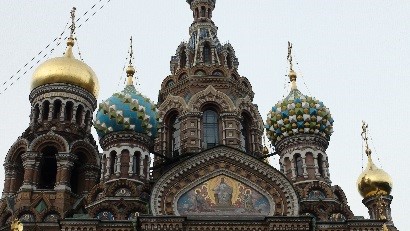
Overnight there was a torrential downpour, which lasted for hours. The morning weather made us realize that the wettest winter we ever spent was a summer in Saint Petersburg. We wandered down the main street of this colorful city (the Nevsky Prospect) to every tourist's first stop, the magnificent Hermitage Museum. It is almost 250 years old and started as Catherine the Great's personal art collection. It was eventually opened to the public in 1852. The collection has a million items, everything from Ancient Greek gold jewelry to Picasso's ceramics and Auguste Rodin's hypnotic sculptures. There were millions of tourists at the museum that we mostly managed to beat with our early rising strategy. The great art of the museum was somewhat lost to us as we never managed to figure out its unfathomable map. Eventually, we escaped the throng, and dodging the rain, we rushed to the nearest cafe for solace in cappuccinos.
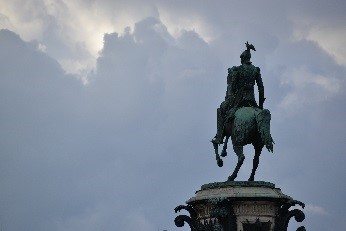
Out on the streets, we continually marveled at the many glamorous young women, with slender bodies, long legs, and usually wearing (very tall) high-heeled pumps. These young women seem out of place compared to the older mothers and grandmothers we saw that were, let me say, much shorter and rounder. It is a mystery to us how the various generations of women can be so physically different.
Saint Petersburg, Russia
Wednesday, August 14, 2013
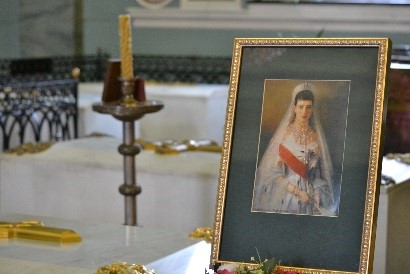
Today, we realized why all the buildings in Saint Petersburg have the biggest drainpipes in the world. There was a lot of water pouring from the sky all day, non-stop, just heavy at first, then very heavy, and then unbelievably heavy. To avoid drowning, we took the second deepest metro in the world to the Peter and Paul Fortress, site of the founding of the city, home to the Tsars' tombs, prison for their political detainees, and ultimately the penitentiary to some of the nobility. Now it's a wonderful museum that does a good job to inform the inquisitive tourist about the city's history from prehistoric humans to 1917 when, according to the museum, history ended for the residents of Saint Petersburg.

We discovered, after attending this great museum, that most of the 19th century in Russia was a time of anti-Tsarist political movements, which were ultimately unsuccessful, and the activists were imprisoned, exiled, or executed. We stood in the room where death sentences were given to the leaders of the Decembrists, who had tried to equalize things and wanted to free the serfs but failed in 1825. We were surprised to discover that nearly every member of the nobility had a Decembrist sympathizer amongst them.
We had no idea what Russian food would be like, but as lovers of beets and cabbage, we had some hope. Limiting ourselves to restaurants with either pictures or English translations, we discovered great food, and beets galore.
Thursday, August 15, 2013
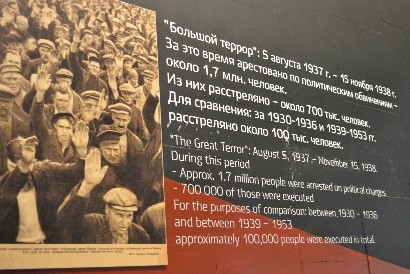
In 1917, Mathilda Kshesinskaya's mansion became the Bolshevik party headquarters. We stood in Lenin's first-floor office and looked out of the balcony where he gave speeches to crowds below. Now, the Art Nouveau mansion, which was built for a prima ballerina and royal mistress who became the wife of Grand Prince Andrei Romanov, is the Museum of Political History. Every story in Russia's past seems incredibly complicated, sad, and thrilling. At each twist in the nation's saga, we kept wondering what might have happened if.... Feeling incredibly sad, we learned about Stalin's gruesome policies. The museum's narrative was definitely critical of the infamous dictator, who left behind a big mess, to say the very least.
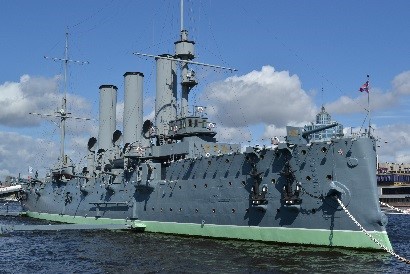
Afterwards, we walked to the Aurora, the naval ship that fired a shot to signal the October Revolution in 1917. We discovered the Field of Mars, where many revolutionaries were interred in mass graves. These days, the city seemed overflowing with brides rushing about having their photos taken. By the end of the emotional day, we were ready for vodka, borscht, and bed.
Earlier this year, back in San Francisco, we encountered Russian bureaucracy for the first time while obtaining our entry visas to this complicated country. During this encounter, we were fined an extra $50 for having commas incorrectly placed (according to the Russian official) in our names on the visa request form. "Oh well," we thought, "There's always a tax you must pay when you travel." However, nothing could have prepared us for our departure experience today. We discovered the full officious and disorganized nature of Russian officialdom. Two security and three passport checks stood between us and our aircraft bound for Berlin. It took four hours at the airport to make a two-hour flight. Dasvidanya, mother Russia, it was nice knowing you.
Berlin, Germany
Sunday, August 18, 2013
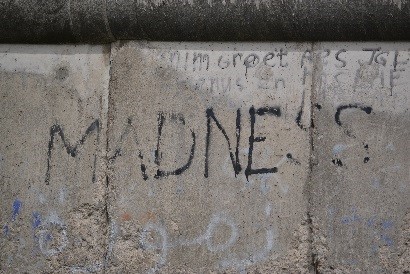
It feels good to be here, in this great modern capital city. Standing at the iconic Brandenburg Gate, which was once in a no-man's land, between the East and the West, because of the Berlin Wall. We thought of Pink Floyd, protests, barbed wire, concrete walls, and people's constant struggle for the fanciful concept of freedom.
It is hard to imagine that this is a city with so many awful stories in its history. Yet the Berliners are not hiding from their past. It is 80 years since the Nazis came to power, and all around the city there is information about the terrible time, and the horrors committed. We visited the site of the Gestapo headquarters, which is now a museum appropriately called the Topography of Terror.
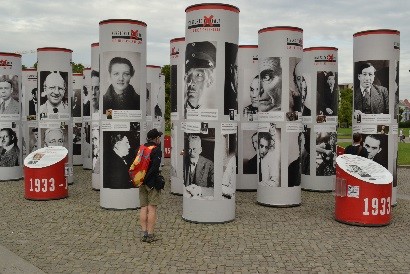
There are no words to convey the feelings you get at this place of terrible memories. This is the spot where Hitler and his henchmen ruled, and where there is a remaining segment of the once massive Berlin Wall. Nearby, a 1950s concrete apartment building covers the location where Hitler spent his last days in his infamous bunker. Moving on through the spacious streets of this great city built upon a marsh, we found Checkpoint Charlie, which is now a rather cheesy tourist photo opportunity. It was so chilling to think of those who lost their lives trying to cross to the West as McDonald's, Starbucks, and Burger King's neon lights flashed in an unending attempt to draw consumers.
Berlin, Germany
Berlin, Germany
(The Great Pin Conspiracy)
Monday, August 19, 2013
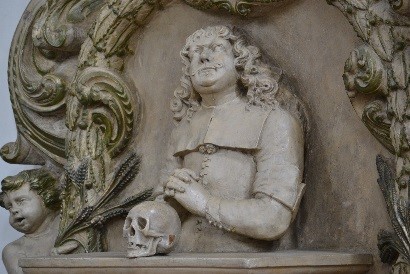
Berlin is a city for pondering big questions, and today's mystery is: why American credit cards do not have PINs. Australia, New Zealand, Asia, and Europe do not require such antiquated procedures as signatures on paper; rather, they all use the modern and green personal ID numbers instead. The PIN technology is ubiquitous worldwide, and without it, American tourists must constantly apologize to non-English-speaking vendors of essential travel goodies and try to inadequately explain: "Sorry, no PIN." Hopefully, the vexed vendor, with the tasty cappuccinos or hotel room, will know how to accommodate us disadvantaged Yankees, to enable us to scrawl our scratching with quill and ink. When, fellow citizens of the United States, will we catch up with the rest of the world?
Moritzburg Castle, Saxony, Germany
(The Unexplained Euro Chasm)
Tuesday, August 20, 2013
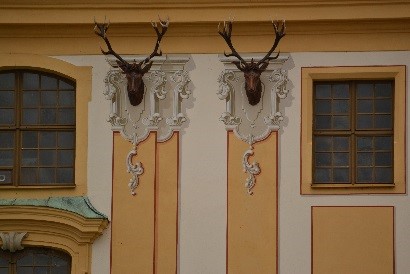
Every night we come home from a long day of driving the Autobahns, or tramping the pavements of great cities, or hiking over hills and through valleys. We long for bed, and once we are between the sheets we attempt to cuddle only to find a chasm between us. Don't worry, Julia and I are still crazy about each other. But what appeared to be a double bed to our tired eyes is, in fact, two singles pushed together, so any close contact is impeded by a large fissure. Is this some kind of antiquated European anti-coitus tactic? Did Augustus the Strong, Prince of Saxony and King of Poland, suffer such callous cruelty?
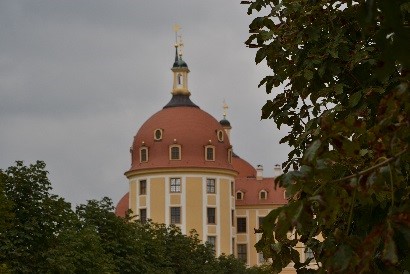
Maybe he did, and his ensuing frustration explains why he was so crazy about hunting deer, chopping off many thousands of their antlers, and hanging them all over the walls of his hunting castle. One will never know. As we look forward to hiking the splendid paths of the Saxony Swiss National Park, we hope to see deer among the wild creatures there; if any have survived that marauding Prince of Saxony and King of Poland. And who knows, perhaps there'll be a real double bed there too.
Moritzburg, Germany
Wiesig, Germany, Saxony Swiss National Park
(The Mystery of the Rats and Farts)
Wednesday, August 21, 2013
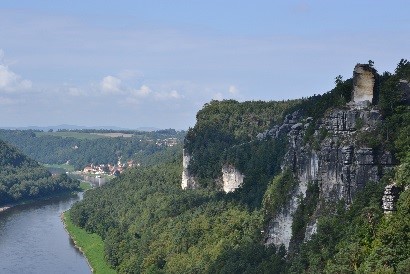
The Germans are really good at making beer; they are extremely talented at creating beautiful window boxes and gardens, and they bake delicious bread. Reputedly, they are also the most efficient and organized of people, but there is little evidence of this skill on the hiking trails and maps of the Saxony Swiss National Park. Nevertheless, we found our way through the maze of wondrous rock formations made from eroded sandstone left behind by a prehistoric seabed.
There are bears, wolves, and lynx in this park, but we just saw lots of good Germans out on a sunny day, as lost as we were, all staring intently at their unintelligible maps.
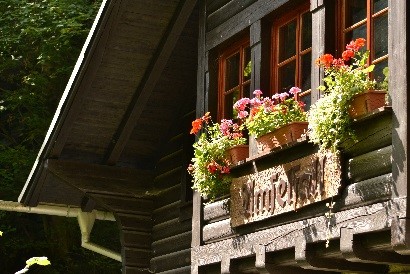
There were villages with cafes and snack bars at every mile on the 8-mile trail we took, even at the top of a thousand-foot precipitous sandstone rock ledge. Everywhere we saw Germans drinking beer and munching on what appeared to be strudel. We finally succumbed to the fantasy of eating real local strudel. We sat down at a table under a window box at a picturesque restaurant.
We had no idea what was on the menu, but hungrily said to the waitress, "Strudel bitte und tea." "Nein strudel," was the curt reply. We ended up with a cup of very weak tea and no strudel, while all around us the locals seemed to be munching on the elusive dessert.
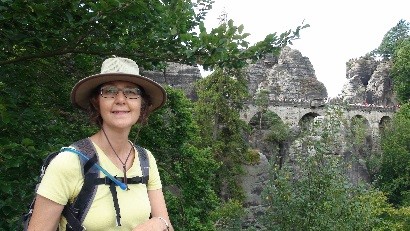
What an incomprehensible world we are in. It's a world full of words containing farts and rats; not sure of the origin of such words, but we must constantly ausfahrt and visit Rathauses; and we still haven't had our strudel.
Wiesig, Germany
Lilienstein, Germany, Saxony Swiss National Park
Thursday, August 22, 2013
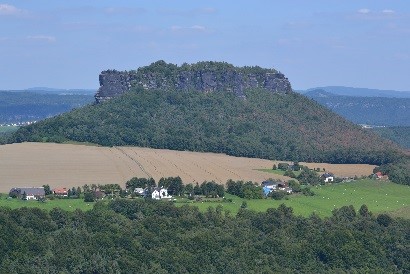
We hiked a 14-mile double 1,300-foot mesa walk today. First, we hiked along the banks of the beautiful Elbe River up to the precipitous rock known here as Lilienstein. From a steep path through a very German forest, we went up and up, then even higher, via metal stairs bolted precariously to the cliff's edge. Finally, we summited the plateau, to find a great vista of the river Elbe below and rock formations as far as our eyes could see. We also discovered a restaurant at the pinnacle of the mountain that sold cappuccinos, along with a wide-ranging menu of other goodies! There are few mountains without a full-service restaurant at the summit in this gastronomic Fatherland.
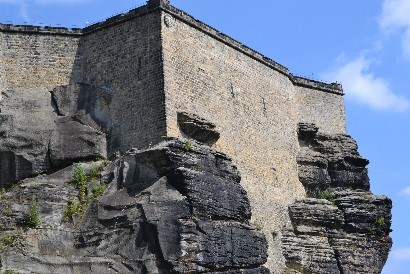
After walking (sometimes climbing) down the other side of Lilienstein, we took a short ferry ride across the Elbe to (a prototype for a Disneyworld village) the little hamlet of Konigstein. Through the town and past the church, then up again another 1,000 feet to what reminded us of Mary Shelley's Dracula Castle; otherwise known as Konigstein Fortress. Luckily, as we were quite tired at this point, we arrived at the fortress' entrance at the same time as a tour bus full of German tourists. This meant that we were absorbed into the crowd and taken up to the castle parapets in a special enormous elevator, big enough for all the passengers of an entire coach and us two lowly hikers. At the top, there were, of course, multiple restaurants to choose from, great views of the wondrous landscape below, and lots of old cannons.

Finally, we left Konigstein Fortress, resisting the rising urge to eat strudel there, and headed back to our lovely hotel in Wiesig. Exhausted, and back at our hotel, we finally did get to eat the elusive apple strudel complete with ice cream, cream, and custard. So much for my strict no processed sugar rule; oh well.
Lilienstein, Germany
Schmilke, Germany, Saxony Swiss National Park
Friday, August 23, 2013
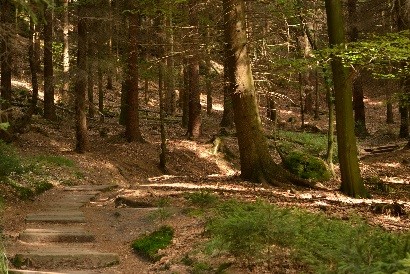
At the village of Schmilke, we found the wild place we had been searching to discover in the Saxony Swiss National Park. On this butte, there is no mountaintop cafeteria; it truly seemed a place where bears and lynx could roam freely. It was a 1,400-foot climb to the top, but once there, we sat on huge boulders and looked out across miles of dense forest stretching off into the Czech Republic. With so much wild space to roam, there must surely be many creatures still living in this vast wilderness.
But the mesa that we were on had long ago been conquered by humankind.
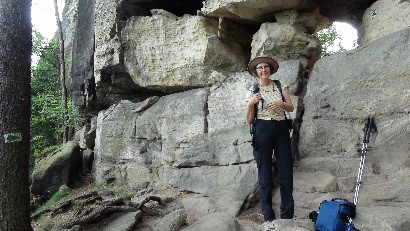
It was laced with metal staircases and crawling with climbers and hikers. Strong German workmen were heaving huge pine logs on their shoulders to repair well-trodden paths. But even the well-used paths dwindled away to secret, less-used trails. With much deliberation over our unfathomable German map, and lots of physical searching, we discovered a trail that led under a massive cliff and through a narrow opening. We squeezed through the constricted hole in the gigantic sandstone wall, not really knowing what lay beyond, but eager to explore. We slid down several feet on the other side to an unknown wilderness beyond. The trail continued and skirted the edge of the cliff face for many kilometers, on some very rough tracks. We sat and dangled our legs from a precipitous cliff edge and ate our cheese sandwiches in a part of Europe that seemed untouched and eternal.
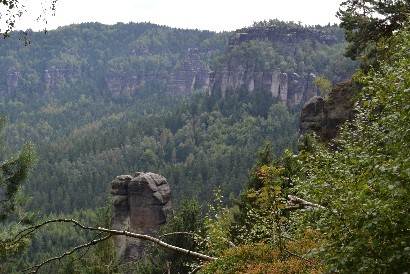
Eventually, we returned to the little town of Schmilke where we had started our adventure. There, we found that the locals had been schmilkering the cows. They made use of all that schmilka by fixing us delicious iced coffee with ice cream floating in it. Plus, they served us a pie that was really a giant blob of whipped cream just barely held together with thin strands of cake. It wasn't strudel, but it sure was good.
Schmilke, Germany